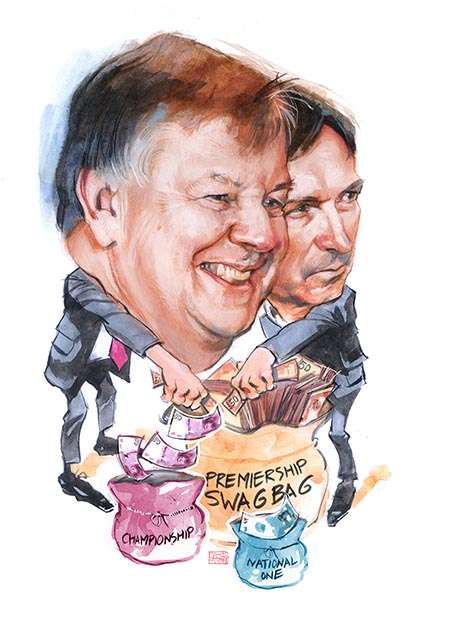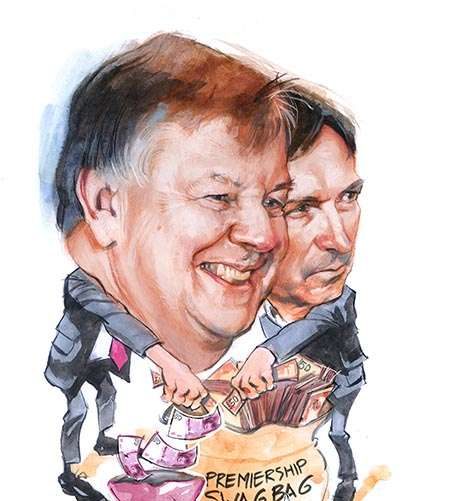 Salary caps are causing strife again, with dire warnings emanating from the Premiership elite as well as from clubs in National One and below. This time it is a classic tale of haves and have-nots, with the RFU caught somewhere between a rock and a hard place having bankrolled the Premiership clubs lavishly, only to underfund the Championship – and throw small change at the clubs in National One to Three.
Salary caps are causing strife again, with dire warnings emanating from the Premiership elite as well as from clubs in National One and below. This time it is a classic tale of haves and have-nots, with the RFU caught somewhere between a rock and a hard place having bankrolled the Premiership clubs lavishly, only to underfund the Championship – and throw small change at the clubs in National One to Three.
Where some clubs in the Premiership are advocating a freeze on this season's new £6.5m salary cap after a rampant rise in player salaries, clubs two leagues below them in National One are up in arms over a proposed RFU edict to limit total player payments to £150,000. This is the equivalent of what a single middle income player at a Premiership club can command.
The rumblings in the Premiership started this summer when we carried a story in which the Gloucester chief executive, Stephen Vaughan, warned that unless there was a wage freeze some Premiership clubs would go into financial freefall.
His Leicester counterpart Simon Cohen also told The Rugby Paper that the vast amounts of extra money pouring into the coffers of the Premiership clubs would go straight into the pockets of players and agents.
The upshot is that a huge increase in broadcast revenue – following a £280 million four-year deal with BT – and the new eight-year £220 million club-country deal signed off this summer by RFU chief executive, Ian Ritchie, is not having the predicted benefits for clubs.
Cohen said that the new salary cap, which in reality is £8.5m because of exemptions for two marquee players and injury dispensation, is potentially ruinous. He argued that the cap, which has doubled from £4.25 million two years ago – and is set to rise by a further £1 million over the next two years – is the source of galloping wage inflation.
Yet, at the other end of the pay-scale we have clubs like Coventry in National One who, as we reported last week, are incensed at an RFU wage-cap plan which means they will be unable to pay entire squads of 35 players any more than the £150,000, which is an average of £4,285 per player. That ceiling drops to £100,000 in National Two, and £50,000 in National Three.
The upshot is an underfunded league structure which is not just financially skewed, but is also stacked against ambitious clubs being able to progress up the ladder. At the moment no-one appears to be satisfied. Coventry have threatened to ignore the wage cap and expect others, such as Moseley and Blackheath, to follow suit despite the threat of punitive RFU action against any non-compliance.
 By contrast, the pain being felt in the Premiership is largely self-inflicted. Cohen says that salary increases across the board of 40 per cent at the start of this season – meaning, for example, that a squad player on £70,000 last season now costs almost £100,000 – have seen overall squad sizes shrink because of the cost, with the prospect of far greater physical demands being placed on players.
By contrast, the pain being felt in the Premiership is largely self-inflicted. Cohen says that salary increases across the board of 40 per cent at the start of this season – meaning, for example, that a squad player on £70,000 last season now costs almost £100,000 – have seen overall squad sizes shrink because of the cost, with the prospect of far greater physical demands being placed on players.
The detrimental implications for player welfare are an obvious and unwanted side-effect. There is also the potential for splits within squads based on disparities in income, with marquee players earning more than double their teammates.
Just as damaging, according to Cohen, is that clubs will struggle to find the revenue available for improving stadiums and training facilities, and that community projects will also be hit.
Cohen's view that, “the salary cap is already at a point where it will be dangerous for the game if it goes any higher”, is not something that any Premiership club, including those with multi-millionaire backers like Bath and Saracens, can afford to ignore.
Leicester are still comfortably the club with the biggest attendances in England, and the reality is that the growth in Premiership crowds is not keeping pace with the size of the wage bills at most clubs. Those costs, according to Vaughan, mean that instead of becoming profitable businesses Premiership clubs are collectively losing millions every season.
This picture is at odds with that painted this time last year by Premiership Rugby's chief executive, Mark McCafferty, following the signing of the BT broadcast deal. Then he said: “This investment is intended to drive the next phase of growth in English club and international rugby.”
Meanwhile, solid investment in the leagues below is something that the Premiership and the RFU seem reluctant to contemplate. While the RFU's desire to see National One clubs which attract crowds of little more than a few hundred live within their means is prudent, the Draconian way in which it is being introduced is not.
It should not be beyond the wit of the RFU to create and part-fund a graded financial structure beneath the Premiership which allows for a reasonable progression from semi-pro in National Three up to National One, with a fully professional Championship above that.
However, the present financial deck is stacked against anyone winning promotion.
There is only one conclusion to be drawn: The massive disparity in funding between the leagues is ultimately designed to ring-fence the Premiership, and to a lesser degree the Championship, by preventing ‘intrusion' from clubs below them. And that the RFU is shifting away from the ideal that promotion and relegation is sacrosanct.


























